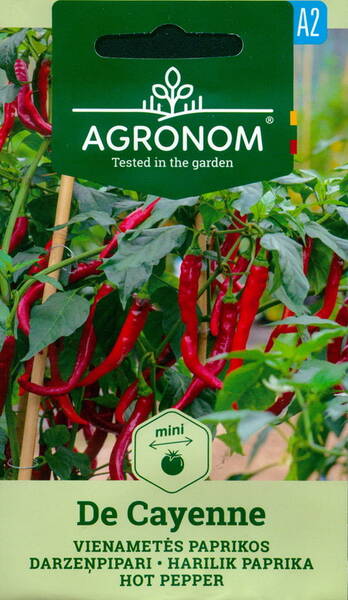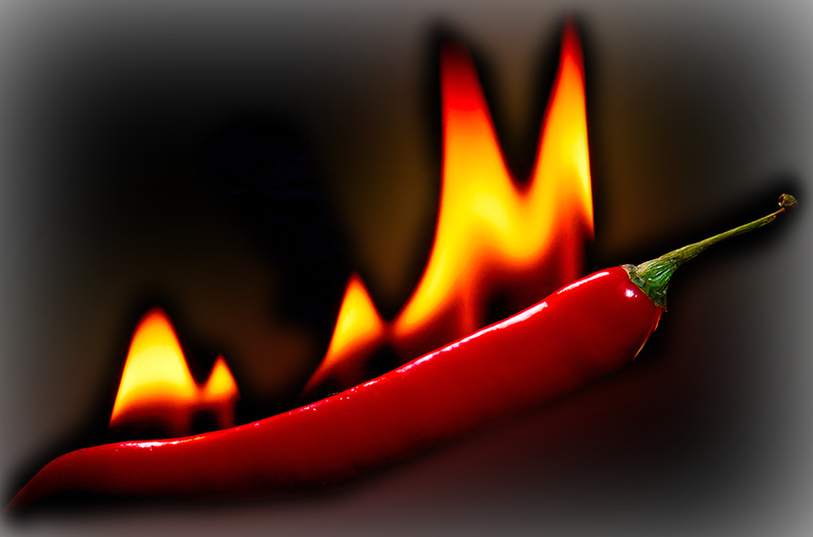Your shopping cart is empty!
Hot pepper "De Cayenne" : 50 000 SHU
Hot pepper "De Cayenne".
A mid-early variety of hot pepper (from transplanting 48-55 days), intended for cultivation in open ground and film greenhouses, is one of the most widespread varieties of hot pepper in the world.
The plant is thermophilic, reaches 60-90 cm in height. Ripe fruits of bright red color, elongated-conical shape, weighing 25-35 g.
The pulp is dark red, thick. Pungent in taste, the fruits are high in vitamins A and C.
Hot pepper also has antioxidant properties, improves appetite and digestion, reduces the risk of cardiovascular disease, and improves blood circulation.
Scoville scale units: 30,000-50,000.
The value of the variety: resistance to the tobacco mosaic virus, high yield, abundant and long-term fruiting, heat resistance. The alkaloid capsaicin gives it a burning taste. It is widely used in medicine for the manufacture of mustard plasters and ointments, capsaicin has a depressing effect on malignant cells, pepper tincture helps with headaches, strengthens the body's defenses, prevents the development of atherosclerosis, and normalizes blood pressure.
A strong aphrodisiac (especially for men), is able to stimulate the production of "hormones of happiness." Cayenne pepper is an integral part of Mexican, African and Asian cuisine. Not having a pronounced taste, it endows the dish with pungency and completely changes the taste and aroma of food, gives a special piquancy to dishes made from meat, fish, cheese, vegetables.
SEEDING: seeds are sown for seedlings in late February and early March. Seeds germinate within 14-22 days.
NB! Care must be taken when handling seeds and fruits.
They dive in the phase of 1-2 true leaves. In unheated greenhouses, 60-65 day old seedlings are planted in late May - early June, according to the scheme 50 x 40 cm. Loamy, breathable soils are preferred.
Good predecessors are cucumber, legumes, cabbage.
CARE: pepper is responsive to the application of phosphorus-potassium fertilizers for better fruit setting and fertilizing with nitrogen fertilizers during the entire growing season. Plants are demanding on soil moisture and low air humidity. Therefore, watering is carried out after sunset with warm water under the root. For the development of the root system, regular loosening of the soil should be carried out.
A mid-early variety of hot pepper (from transplanting 48-55 days), intended for cultivation in open ground and film greenhouses, is one of the most widespread varieties of hot pepper in the world.
The plant is thermophilic, reaches 60-90 cm in height. Ripe fruits of bright red color, elongated-conical shape, weighing 25-35 g.
The pulp is dark red, thick. Pungent in taste, the fruits are high in vitamins A and C.
Hot pepper also has antioxidant properties, improves appetite and digestion, reduces the risk of cardiovascular disease, and improves blood circulation.
Scoville scale units: 30,000-50,000.
The value of the variety: resistance to the tobacco mosaic virus, high yield, abundant and long-term fruiting, heat resistance. The alkaloid capsaicin gives it a burning taste. It is widely used in medicine for the manufacture of mustard plasters and ointments, capsaicin has a depressing effect on malignant cells, pepper tincture helps with headaches, strengthens the body's defenses, prevents the development of atherosclerosis, and normalizes blood pressure.
A strong aphrodisiac (especially for men), is able to stimulate the production of "hormones of happiness." Cayenne pepper is an integral part of Mexican, African and Asian cuisine. Not having a pronounced taste, it endows the dish with pungency and completely changes the taste and aroma of food, gives a special piquancy to dishes made from meat, fish, cheese, vegetables.
SEEDING: seeds are sown for seedlings in late February and early March. Seeds germinate within 14-22 days.
NB! Care must be taken when handling seeds and fruits.
They dive in the phase of 1-2 true leaves. In unheated greenhouses, 60-65 day old seedlings are planted in late May - early June, according to the scheme 50 x 40 cm. Loamy, breathable soils are preferred.
Good predecessors are cucumber, legumes, cabbage.
CARE: pepper is responsive to the application of phosphorus-potassium fertilizers for better fruit setting and fertilizing with nitrogen fertilizers during the entire growing season. Plants are demanding on soil moisture and low air humidity. Therefore, watering is carried out after sunset with warm water under the root. For the development of the root system, regular loosening of the soil should be carried out.
Did you know that... the first Europeans who experienced the burning effects of these red pods were the Spanish conquerors...
When they approached the camp of the South American Indians with bad intentions, clouds of unusually acrid and suffocating smoke poured in their direction, after which the valiant conquistadors were forced to flee, painfully coughing and sneezing...
A handful of dried fruits, which were thrown into the fire, acted on them like a chemical weapon!













